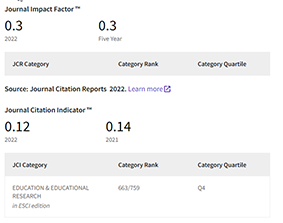Pupils and Sources in Late Medieval Lyon
DOI:
https://doi.org/10.14516/ete.2015.002.002.014Keywords:
France, sources, pupils, medieval educationAbstract
The medieval elementary and grammar-school pupil is a partially-hidden figure in the documentary sources of the period. Their existence, and their existence in abundance, is clear from the fact that so many schools and teachers were operating in the later Middle Ages. Evidence specific to the schoolchild, however, is lacking and the researcher has to explore documents in lateral way in order to find information on their everyday experiences. Even identifying individual pupils by name can be difficult. This article will explore the archival sources available in French cities, in this case the city of Lyon, in an effort to identity possible sources of data on the medieval schoolchild. It will look at sources that name pupils, either as groups or as individuals, and it will discuss what evidence for their daily lives can be extrapolated from a selection of documents. The documents examined in the article include the proceedings of ecclesiastical chapters, school statutes, obituaries, wills, proceedings of the municipal council, and pedagogical literature. Some of these must be closely read in order to find the children and pupils within their pages but they are there, often in surprising circumstances, such as the illegitimate children who received legacies from the parents and other family members in order to pursue their education and the pupils who had early-printed works dedicated to them. This article will serve as a map for other scholars seeking to study pre-modern school children.
References
Aubert de la Chesnave-Desbois, F. A. (1876). Dictionnaire de la noblesse, 15 vols. Paris: Boudet.
Beyssac, J. (1907). Jean de Rochetaillée. Lyon: A. Rey.
Black, R. (2001). Humanism and Education in Medieval and Renaissance Italy: Tradition and Innovation in Latin schools from the Twelfth to the Fifteenth century. Cambridge: Cambridge University Press.
Charvet, L. (1872–73). Le Collège de la Trinité, Lyon; son histoire sommaire et se topographie. Mémoires de la Société littéraire de Lyon, pp. 209-239.
Clerval, A. (1899). L’Ancienne Maitrise de Notre-Dame de Chartres du Ve siècle a la Revolution. Paris: Poussielgue et Picard et Fils.
Copenhaver, B. (1979). Symphorien Champier and the Reception of the Occultist Tradition in Renaissance France. New York: Mouton.
Fabia, P. (1934). Pierre Sala: Sa vie et son oeuvre avec la legend et l’histoire de l’Antiquaille. Lyon: Audin.
Fédou, R. (1988). Paysans et bourgeois. Essor économique et réveil urban (XIIe–XIIIe siècles). In Latreille, A. (Ed.), Histoire de Lyon et du Lyonnais (pp. 93-109). Toulouse: Privat.
Fédou, R. (1964). Les Hommes de loi lyonnais à la fin du Moyen Âge: Étude sur les origines de la classe de robe. Paris: Sociét d’Édition Les Belles Lettres.
Forest, A. (1885). L’École cathédrale de Lyon: Le Petit seminaire de Saint-Jean. Paris & Lyon: Delhomme & Briguet.
Fournier, M. (Ed.) (1970). Les Statuts et privilèges des universités françaises depuis leur foundation jusqu’en 1789, 4 vols. Paris: Larose & Forcel, 1890-1894; repr. Aalen: Scientia Verlag Aalen.
Garin, F. (1978). La complainte de François Garin, marchand de Lyon (1460). Lyon: Presses universitaires de Lyon.
Gerson, J. (1960-1973). Pro pueris ecclesiae Parisiensis. In Glorieux, P. (Ed.), Oeuvres complètes, 10 vols. Paris: Desclée.
Gerson, J. (1960-1973). Oeuvres completes, 10 vols. In Glorieux, P. (Ed.), Paris: Desclée.
Guigue, M. C. (Ed.) (1867). Obituarium lugdunensis ecclesiae. Nécrologie des personnages illustres et des bienfaiteurs de l’Église métropolitaine de Lyon du IXe au XVe siècle. Lyon: Scherring.
Guigue, M. C., Guigue, G. (1886). Bibliothèque historique du Lyonnais, memoires, notes et documents, 2 vols. Lyon: Vitte & Perrussel.
Guilbert, S. (1982). Les Écoles rurales en Champagne au XVe siècle: Enseignement et promotion sociale. Annales de l’Est, pp. 127-147.
Gonon, M. (1968). La Vie quotidienne en Lyonnais d’après les testaments XIV- XVI siècles. Paris: Société d’édition «Les Belles Lettres».
Groag Bell, S. (1988). Medieval Women Book Owners: Arbiters of Lay Piety and Ambassadors of Culture. In Erler, M., Kowaleski, M. (Eds.), Women and Power in the Middle Ages (pp. 149-87). Athens, GA: University of Georgia Press.
Hanawalt, B. (1993). Growing Up in Medieval London: The Experience of Childhood in History. Oxford: Oxford University Press.
Jerome, St. (1933). Select Letters of St. Jerome, trans. by Wright F.A. London: William Heinemann.
Kallendorf (trans. & ed.) (2002). Humanist Educational Treatises. Cambridge, MA: Harvard Unviersity Press.
Lynch, S. (2013). The Children’s Cloister: Choirboys and Space in Late-Medieval Cathedrals. Bulletin for International Medieval Research, 19 (2013), pp. 44-61.
Péricaud, A. (1838). Notes et documents pour servir à l’histoire de Lyon. Lyon: Pélagaud, Lesne & Crozet.
Picot, J. (1970). L’Abbaye de Saint-Pierre de Lyon. Paris: Société d’Édition Les Belles Lettres.
Pins, J. de (2007). Letters and Letter Fragments. Geneva: Droz.
Planchart, A. E. (1993). The Early Career of Guillaume Du Fay. Journal of the American Musicology Society, 46(3), pp. 341-68.
Pourrat, A. J. (1899). L’Antique école de Leidrade: XIe centenaire de sa fondation. Lyon: Emmanuel Vitte.
Renouard, P. (1967). Bibliographie des impressions et des oeuvres de Josse Badius Ascensius, imprimeur et humaniste, 1462–1535, 3 vols. New York: Burt Franklin.
Seville, I. (1991). Etymologiarum sive originum, 2 vols. Oxford: Clarendon.
Shahar, S. (1990). Childhood in the Middle Ages. London: Routledge.
Wright, C. (1989). Music and Ceremony at Notre Dame of Paris, 500–1550. Cambridge: Cambridge University Press.







